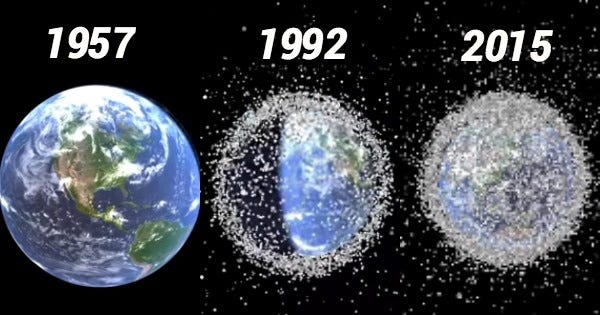Maya Khandekar- Space Junk
As Americans, we dispose of 254 million tons of trash per year (equivalent to more than 1 million whales). To accommodate this large disposal of trash in the US, there are more than 2,000 landfills in the US that are at their full capacity. But what about all the trash floating around earth’s orbit? Over the years as we launch more and more objects into space, there has been a build-up of “space junk” that is in our earth’s orbit. Space Junk refers to small pieces of orbital debris such as abandoned spacecrafts and satellites, rocket launch fuel, and small flecks of paint from launched items that damage other objects that orbit the earth. As the world keeps launching more objects in space every year, we are not “cleaning up” the trash left behind in the earth’s orbit leading to 95% of all objects in orbit to be dead satellites or pieces of inactive material. Currently, there are more than 20,000 pieces of debris larger than a softball and 500,000 pieces of debris the size of a marble. And some small debris cannot be tracked as it is so small, but the damage these pieces can cause is extreme. Pieces of debris can travel up to 17,500 mph and are fast enough to create enough damage to active objects orbiting the earth.
"Damage to the Space Shuttle Endeavour from a collision with piece of space debris or a micrometeorite.Credit: NASA"
The problem with Space Junk is that these small pieces of debris can cause major destruction of satellites, the ISS, space shuttles, and astronauts. No matter how small the debris may be, the damage can be major since the debris travels at such great speed. This debris can break exterior surfaces and ruin the object in a whole. Other bigger objects that collide with alive technologies can cause these expensive objects to break and be destroyed and no longer able to be used. Other items in earth’s orbit such as rocket launch fuel containers can cause explosions to occur when this fuel collides with other objects at fast speeds. Explosions can result in the destruction of man-made technologies that are used for research or other purposes. The damage from Space Junk on astronauts can be very fatal, as the suits used by astronauts are not protective enough to protect people from these objects. Since these objects travel more than 17,500 mph they can penetrate the suit and hurt people in space.

In order to reduce the Space Junk that orbits our earth, China took action in 2007 by trying to destroy the dead satellites, but their attempt backfired and by destroying the debris, few thousand more pieces of junk were in earth’s orbit which also made it harder to track these smaller pieces. Space agencies are trying to solve the problem in our orbit by creating satellites that can burn up in Earth’s atmosphere, or by creating satellites that can travel higher to less crowded orbits. This action is vital to reduce the amount of Space Junk in the planet’s orbital as Space Junk increases the chances of new technologies that are launched in the air of being destroyed. Without any action in removing Space Junk, it would be hard to launch more object into space. Although our actions as students in the community cannot do much to help the problem of Space Junk we can help support these agencies that are trying to help the issue since Space Junk can hinder further research by destroying new space technologies that can help our scientists learn more about the universe and our planet. This Space Junk can also lead to destroyed satellites which can take away communication, military needs, and GPS, which is vital for our modern society.
Questions:
How can Space Junk affect our daily life?
What other ways can new technology in space have a negative consequence?
Resources:
https://www.nasa.gov/mission_pages/station/news/orbital_debris.html
https://www.nature.com/articles/d41586-018-06170-1
https://science.howstuffworks.com/space-junk2.htm
https://www.saveonenergy.com/land-of-waste/
https://www.globalcitizen.org/en/content/us-landfills-are-filling-up/
http://news.mit.edu/2017/space-junk-shards-teflon-0619
https://quarkmag.com/is-space-junk-a-problem-67e865f702a9
Comments